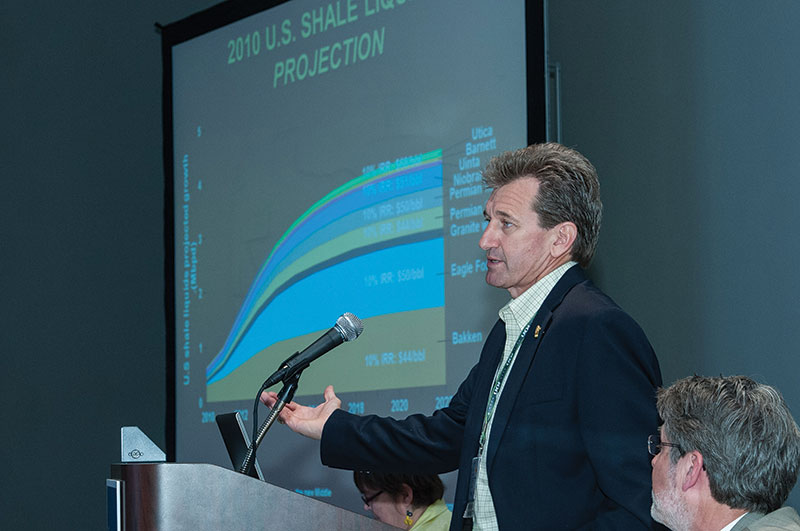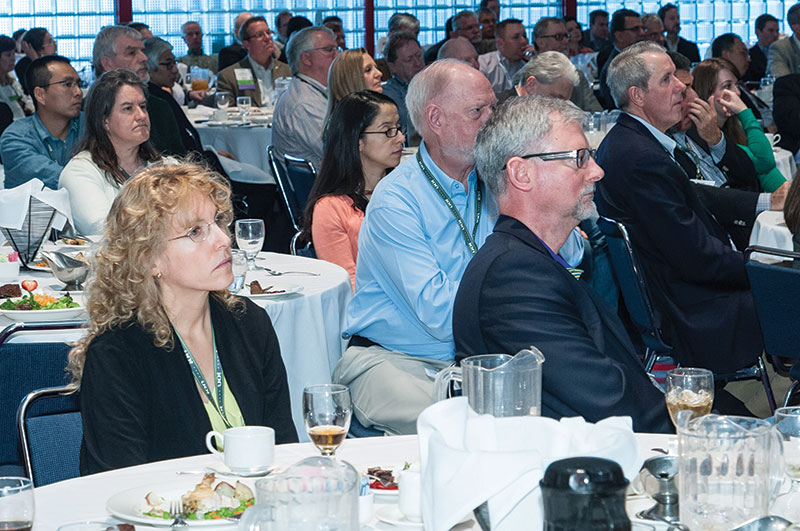When you need in-depth, science-based information on shale plays and issues, AAPG past president Scott Tinker has the reputation as the go-to guy.

Scott Tinker, speaking at the EMD luncheon in Houston.
When you need in-depth, science-based information on shale plays and issues, AAPG past president Scott Tinker has the reputation as the go-to guy.
He played that role again at the recent AAPG Annual Convention and Exhibition in Houston.
Tinker was a high profile presence at the ACE in Houston, where he chaired a forum focused in large part on hydraulic fracturing and was the featured speaker at the EMD luncheon talking about, of course, shale.
For starters he emphasized that the relatively new shale phenomenon is not a revolution as it’s usually tagged.
“It’s an evolution, although pretty quick,” he said. “The technology, demand, creativity, risk – the things we’ve always had in this business – drove this evolution.”
Attesting to its impact, Tinker noted humorously: “In the 1980s, if you cored a shale, you got fired; in 2010 if you didn’t core a shale, you got fired.”
Tinker is the Texas state geologist and also professor, Edwin Allday endowed chair in subsurface geology, at the Jackson School of geosciences, University of Texas at Austin.
He’s also a movie star of sorts, having appeared in theatrically released energy related films. The latest is the award-winning “Switch,” which he conceived and guided through the production process.
It’s widely known that the legendary George Mitchell and his company team spent 17 years doggedly pursuing the needed technology to economically produce the now-famous Barnett Shale. Their ultimate success is widely recognized as the harbinger of the current “shale boom.”
The Barnett, along with the Haynesville, Fayetteville and Marcellus shale plays are included in a four-basin study of shale gas reserves funded by the Alfred P. Sloan foundation and conducted by the Bureau of Economic Geology on Tinker’s turf at the University of Texas at Austin.
The study showed that the Barnett itself is an enormous resource with huge potential, even at somewhat low prices.
In the base case using $4 gas, the assessment forecasts a cumulative 44 TCF of recoverable reserves from the Barnett through 2050 based on already-drilled wells and wells to be drilled through 2030.
The Fayetteville assessment, which followed the same methodology as the Barnett, integrating engineering, geology and economics, estimated technically recoverable gas reserves of 38 TCF for the region. Eighteen TCF reportedly will be economically feasible to recover at $4/mcf.
“There’s a lot of natural gas in the world, a lot of shale gas and tight gas here,” Tinker noted. “As a result of this shale evolution, the price of gas in the United States is about $4, but in the rest of the world it’s $10, $12, $16.”
Implications and Considerations
Tinker pondered aloud during his luncheon talk as to how long this still-evolving action will last.
After all, there is plenty of anger in some corners of the United States, and elsewhere around the world, about a number of issues associated with shale drilling. Hydraulic fracturing no doubt is the largest of the perceived threats in the public domain.
A relatively new concern is the now-unusual flaring of natural gas in oil/liquids-rich plays, particularly the Bakken in North Dakota and the Eagle Ford in Texas.
“Flaring gas – didn’t we quit doing that last century?” Tinker asked. “It’s coming at us like a train, and we need to figure out what to do with this gas.
“It’s energy, it’s methane emissions, it’s CO2,” he noted. “We can fix this; there are a lot of options for using this gas.”
There’s a substantial amount of work awaiting, judging from Tinker’s to-do list.
Much of it is environmental-related.
Environmental implications include:
- Traffic/noise/light.
- Land.
- Earthquakes.
- Water.
- NORM.
- Methane and carbon.
He noted that security issues come into play as well – and the two aren’t mutually exclusive.
Regulatory considerations include:
- Mandatory baseline data.
- Cement all gas producing zones.
- Minimize fresh water use on the front end.
- Full disclosure of chemicals.
- Handle flowback and produced water (treat and reuse; dispose – characterize for faults).
- Minimize methane emissions.
- Minimize surface impact.
- Horizontals minimize the number of well pads.

Scott Tinker talking about shale proved to be a big draw for the EMD in Houston.
A Different Conversation?
Amidst all the frequent hubbub of shale-angst emanating from a number of sources is an unspoken, yet profound, basic fact in the overall energy picture.
“Most people don’t know how electricity or gas are made,” Tinker noted. “And they likely don’t care.
“The public is free not to like everything, but this means we must take the energy conversation to a different place,” he said.
“The conversation we need to have is about the things that energy provides to the world,” he emphasized.
Speaking about the world, a question arose from a luncheon attendee: “Do shales stop at the modern coastlines?”
If you get a handle on how to economically drill and develop shale plays offshore, say goodbye to any financial worries you might have.